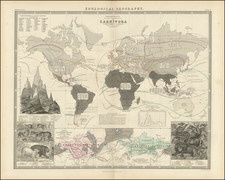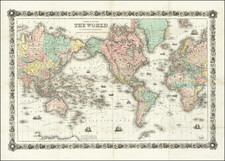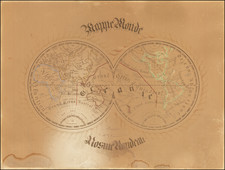Extraordinary double hemisphere wall map of the World, first published by Jean Boisseau in Paris in 1645, the first double hemisphere wall map of the World published in France.
The map is of tremendous importance as both a French historical artifact and for its inclusion of two remarkable cartographic features, a unique configuration of the island of California and a fascinating new projection for the coast of Australia. As noted by Shirley:
Australia is particularly interesting as Boisseau has listed the Dutch landings on the east coast (Concorde 1616, Edels 1619, Lewin 1622, Nuitz 1627), together with names on the coast of Carpentaria. Between is a large hypothetical gulf, perhaps and enlargement of the Gulf of Carpentaria. This unusual configuration was to be followed by Sanson in the 1650s until replaced by more accurate renderings of Tasman's voyages.
First published circa 1645, the map is meticulously compiled and includes the best available cartographic content. Shirley notes:
This large and distinctive map in eight ships by Jean Boisseau is the first French wall map of the world apart from [Guillaume] Postel's [map of 1581]. The design and engraving of Boisseau's map is of the highest standard . . .
The Passage de Browers in 1643 is marked off the southern tip of South America. California is drawn as a differently-shaped island compared to the current outline on Dutch maps of the time.
In 1643 Boisseau had been responsible for "the first true world atlas produced in that country [France]" (Burden), the Tresor des cartes Geographiue. He followed up this work with the publication of the present monumental map, the first French double-hemisphere wall map of the World, published circa1645. This latter fact is of great historical importance in the history of commercial cartographic publication in France, as by the end of the 17th Century, France would assume the dominant role in the production of commercial maps and decorative wall maps, a history which begins with Boisseau's monumental production.
The map bears several cartouches:
- To lower left is an elaborate dedicatory cartouche, surmounted by the coats-of-arms of the Rhineland Palatinate, and flanked by cameos of the circumnavigators Edward Cavendish, Francis Drake, and Ferdinand Magellan. The map is dedicated to Prince Edward of the Rhineland Palatinate (1625-1663), and Prince Philip of the Rhineland Palatinate (1627-1650). The princes, whose father Frederick (1596-1632) was Elector Frederick V of the Palatine of the Rhine, and King of Bohemia, spent a great deal of their formative and adult years in and around the Dutch and the French court, having being exiled from their lands by the Holy Roman Emperor in 1622. Edward settled permanently in Paris in 1645 having married Anna Gonzaga, the daughter of the Duke of Mantua.
- To the lower right within a cartouche is an explanation of latitude and longitude.
- To the upper left is a description of the New World.
The four corners of the map are embellished with personifications of the four seasons in the guise of young women of the court: to the upper left spring holds a flower; upper right summer bears a fan and a sickle; lower left, autumn bares the harvest and a glass of wine; whilst in the lower right winter warms herself next to an open fire. The four elements are represented by four Roman gods: fire - Jupiter; air - Juno; water - Neptune; and earth - Gaia. Finally, to the upper and lower centre of the map are two celestial charts of the northern and southern hemispsheres.
The present maps bears the imprints of the geographer Pierre Duval (dated 1672 in the upper left text panel) and the engravers Francois and Gerard Jollain.
The first state of the map is known in a single example (BNF) and has no title or text panels. The present state also survives in a single recorded example, and is the only example which includes texts panel on all four sides of the map (Yale University). Two other surviving examples of the map without the lower text panels are recorded at the Rijkmuseum 'Nederlands Scheepvaart Museum' Amsterdam, and at the Houghton Library Harvard.
Pierre Duval (1618-1683) was a French geographer, cartographer, and publisher who worked in Abbeville and Paris during the seventeenth century. He was born in the former city, in northeast France, before moving to Paris. Duval was the nephew of the famous cartographer Nicolas Sanson, from whom he learned the mapmaker's art and skills. Both men worked at the royal court, having followed the royal request for artists to relocate to Paris. In addition to numerous maps and atlases, Du Val's opus also includes geography texts. He held the title of geographe ordinaire du roi from 1650 and died in 1683, when his wife and daughters took over his business.











![(World) Tabu. Nova Orbis [New Map of the World]](https://storage.googleapis.com/raremaps/img/small/102996.jpg)

![[Early Photographic Facsimile of the 1527 Weimar Spanish World Map]](https://storage.googleapis.com/raremaps/img/small/67281.jpg)
![[Early Facsimile] Novissima ac Exactissima Totius Orbis Terrarum Descriptio Magna cura & industrial ex optimist quibusq[uae] tabulis Geographicis et Hydrographicis nuperrimisq[uae] doctorum virorum observationib. duobus planisphaerijs delineata Auct. J. Hondio.](https://storage.googleapis.com/raremaps/img/small/69822.jpg)